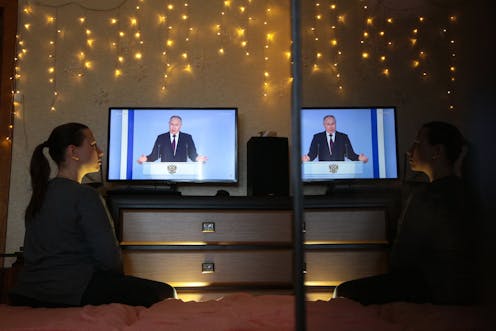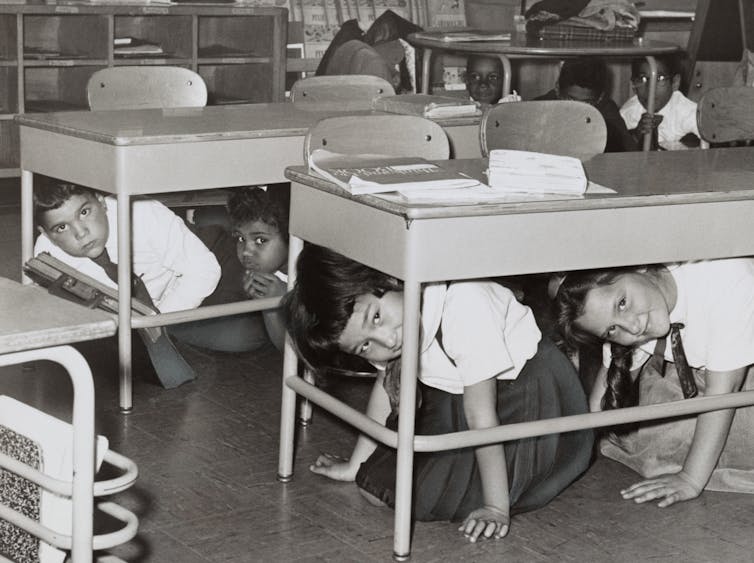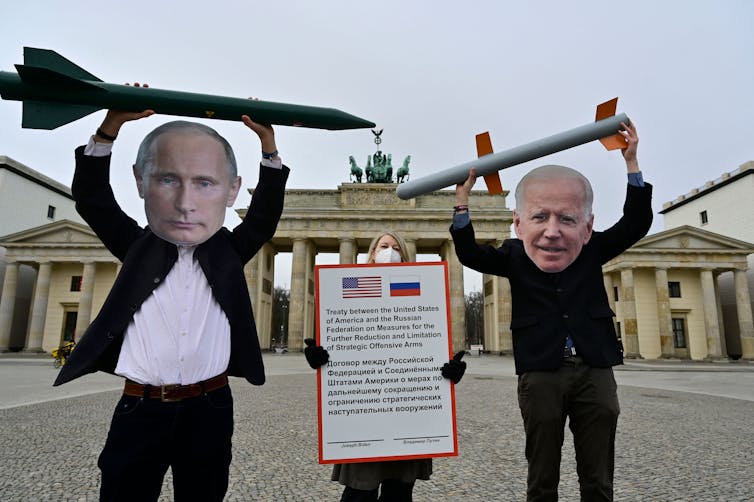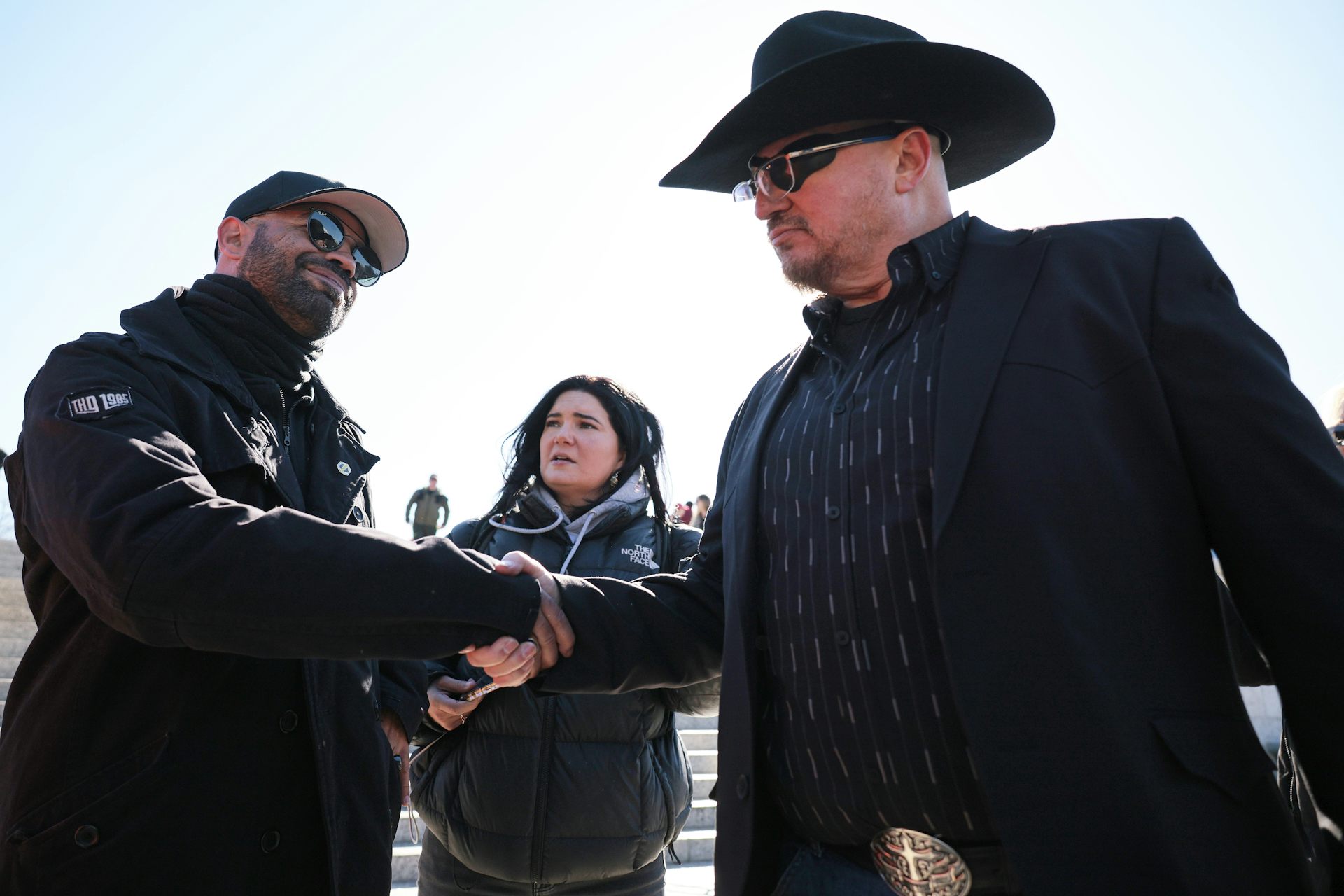Russia announces its suspension from last nuclear arms agreement with the US, escalating nuclear ten
Putin’s announcement to Russia will no longer participate in the New START pauses the last remaining nuclear weapons agreement between the U.S. and Russia.

After decades of progress on limiting the buildup of nuclear weapons, Russia’s war on Ukraine has prompted renewed nuclear tensions between Russia and the United States.
Russian President Vladimir Putin said in his annual State of the Nation address on Feb. 21, 2023, that Russia is “suspending” its participation in the U.S. and Russia’s last remaining nuclear arms agreement – known as New START.
“Our relations have degraded, and that’s completely and utterly the U.S.’s fault,” said Putin, who stopped short of entirely withdrawing Russia from the deal that aims to limit nuclear arms expansion.
In the same speech, Putin threatened to resume nuclear testing if the U.S. does the same, claiming that the U.S. is considering renewed nuclear testing. The U.S. has repeatedly reaffirmed that it can modernize and certify the reliability of its nuclear weapons without resorting to testing.
The U.S. State Department quickly condemned Putin’s announcement, and NATO Secretary-General Jens Stolenberg said that Russia’s suspension from the deal makes the world a more dangerous place.
Putin’s announcement greatly weakens the last remaining arms control agreement but does not immediately terminate it. By “suspending” rather than withdrawing from the treaty, Putin retains the possibility of reactiving the agreement – without having to renegotiate it or have the U.S. Congress ratify it once more.
The New START is the only remaining agreement between the U.S. and Russia limiting the development of nuclear weapons and their delivery systems. It allows both countries to regularly, and with limited advance notice, inspect each other’s nuclear weapons arsenals.
I have worked on and researched nuclear nonproliferation for two decades.
Convincing countries to reduce their nuclear weapons stockpiles or renounce the pursuit of this ultimate weapon has always been extremely difficult.

A history of nonproliferation
The Soviet Union, U.S., United Kingdom, France, Israel and China had active nuclear weapons programs in the 1960s.
Countries recognized the risk of a nuclear war in the future.
Sixty-two countries initially agreed to what’s been called the “Grand Bargain” in 1967, an essential element of the Treaty on the Nonproliferation of Nuclear Weapons. One hundred and ninety-one countries eventually signed this treaty.
The agreement prevented the spread of nuclear weapons to countries that didn’t already have them by 1967. Countries with nuclear weapons, like the U.S. and the U.K., agreed to end their nuclear arms race and work toward eventual disarmament, meaning the destruction of all nuclear weapons.
This landmark agreement laid the groundwork for agreements between the U.S. and the Soviet Union to further reduce their nuclear weapons and their delivery systems. It also stopped other countries from developing and testing nuclear weapons until the end of the Cold War.
Israel, India and Pakistan never joined the agreement because of regional security concerns. They all now possess nuclear weapons. North Korea withdrew from the agreement and developed nuclear weapons.
Some successes
There have been major achievements in preventing countries from gaining nuclear weapons and dramatically reducing nuclear weapons stockpiles since the Cold War.
The global nuclear stockpile has been reduced by 82% since 1986, from a peak of 70,300, with nearly all of the reductions in the U.S. and Russia, who held the largest stockpiles at the time.
Globally there are now around 12,700 nuclear weapons, with about 90% held by Russia and the U.S. – or between 5,000 to 6,000 weapons each.
Several other countries have nuclear weapons, and most of them have a few hundred weapons each, including the United Kingdom, France and China – though China has been building up its nuclear stockpile. Newer nuclear countries like India, Pakistan and Israel have around 100 each, while North Korea has around 20.
Starting in the late 1960s, countries agreed to more than a dozen legally binding agreements, or treaties, that limited new countries from getting nuclear weapons and prohibited nuclear weapons testing, among other measures.
But they have not reduced the number of nuclear weapons with short-range missiles.
No agreements cover these weapons, which could also cause widespread destruction and deaths.

U.S.-Russia cooperation declines
U.S.-Russia engagement on nuclear weapons changed when Russia forcibly annexed Crimea from Ukraine in 2014.
Russia built up land missiles in Kaliningrad, an enclave of Russia in the middle of Eastern Europe, in 2014.
The U.S. and NATO then accused Russia of violating a 1987 nuclear agreement on short- and intermediate-range land missiles. From Russia, these could travel from 311 to 3,418 miles (500 to 5,500 kilometers), hitting targets as far as London.
The U.S. also terminated this agreement in 2019 because of reported Russian violations. Now, there are no international nuclear agreements in Europe.
The New START agreement, signed by Russia and the U.S., remains the one main strategic nuclear weapons agreement in place.
It was to continue until at least 2026.
The U.S. and Russia halted all inspections of each other’s nuclear weapon sites and operations in 2020 due to the COVID-19 pandemic. Yet, hundreds of notifications were still exchanged between the two states, reducing the likelihood of miscalculations and misunderstandings. In November 2022, Russia canceled talks to resume inspections. The U.S. considers these violations of the agreement, but not an altogether outright material breach of the treaty.
Impact of Ukraine war
Putin has repeatedly ignited concern that Russia’s setbacks during its nearly year-old war with Ukraine – as well as Western involvement in the conflict – could result in Russia’s launching a nuclear attack on Ukraine or another country in the West.
A single nuclear weapon today in a major city could immediately kill anywhere from 52,000 to several million people, depending on the weapon’s size.
The U.S. and Russia’s arms control regime was successful in the Cold War because it included significant verification mechanisms – direct inspections of each party’s nuclear arsenal with less than 24 hours’ notice.
Russia and the U.S. have conducted 306 inspections since New START took effect in 2011. Without New START, all inspections of nuclear bases and support facilities will end.
During nuclear talks in 1987, President Ronald Reagan translated a Russian maxim, saying, “trust, but verify,” the foundation of the nuclear arms control regime.
If the U.S. and Russia are no longer transparent about their nuclear arsenals and developments, pressure for both countries to develop new nuclear weapons and delivery systems will increase, along with the risk of miscalculations.
The U.S. State Department already told Congress in January 2023 that Russia is not complying with New START. Russia has denied these accusations and accused the U.S. of violating the agreement as well. Putin reiterated these accusations on Feb. 21, 2023.
While Putin has not followed through on his threat of a nuclear strike, the potential for a nuclear attack has meant the U.S. and NATO have responded to Russia’s attack on Ukraine with this lingering threat in mind.
The U.S. and NATO members announced in January and February 2023 plans to increase their military assistance) to Ukraine. This might signal a change to the United States’ and NATO countries’ strategy, so far, of limiting their direct support to Ukraine and avoiding further escalation with Russia in the conflict.
This is an updated version of an article originally published on April 8, 2022.
Nina Srinivasan Rathbun does not work for, consult, own shares in or receive funding from any company or organization that would benefit from this article, and has disclosed no relevant affiliations beyond their academic appointment.
Read These Next
The ‘sacred’ pledge that will power the relaunch of far-right militia Oath Keepers
Founder Stewart Rhodes says he will relaunch the group, serving as an important outlet for thousands…
AI agents arrived in 2025 – here’s what happened and the challenges ahead in 2026
AI systems began a major shift in 2025 from content creators and chatbots to agents capable of using…
Resolve to network at your employer’s next ‘offsite’ – research shows these retreats actually help f
Because they can help you get to know more of your co-workers, offsites may build the kind of trust…






